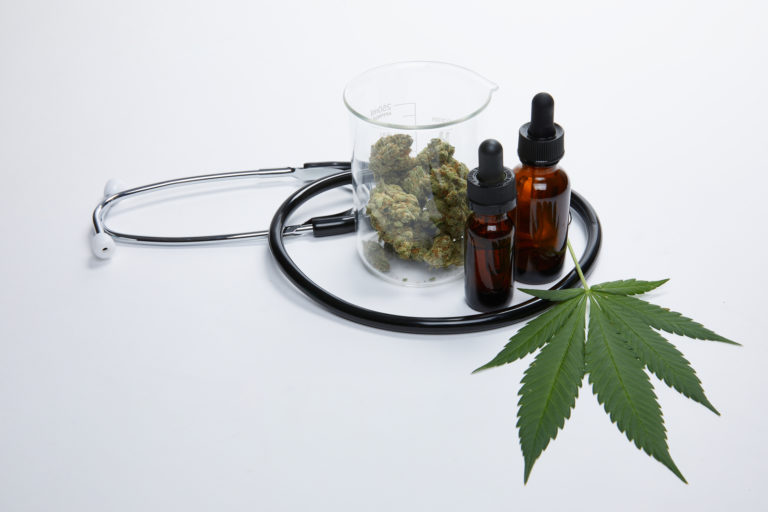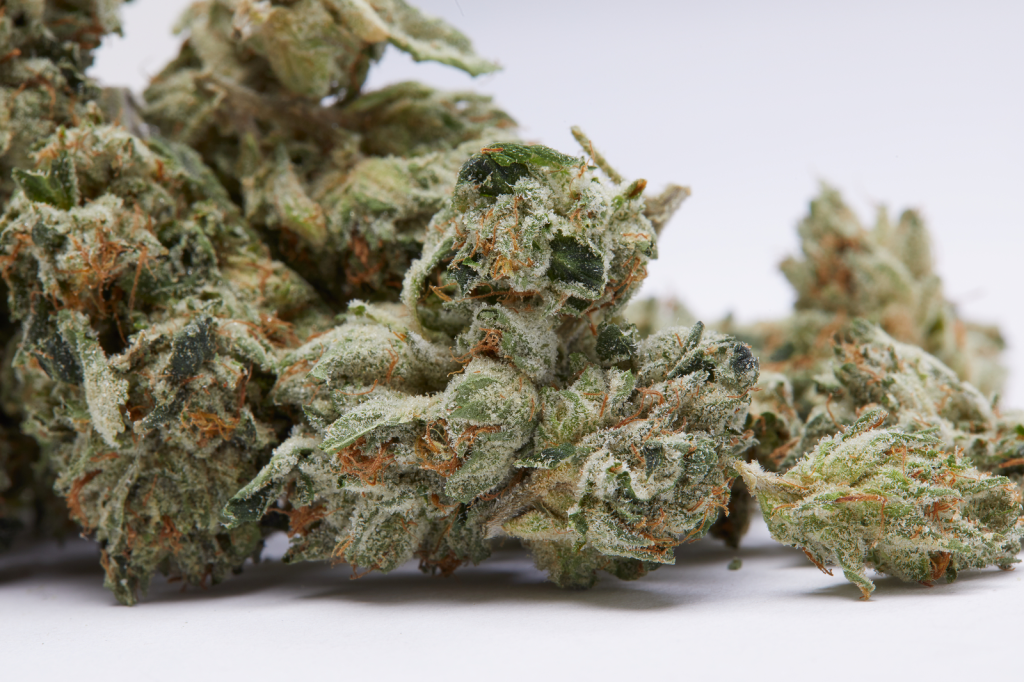Prolonged, chronic cannabis use can cause cannabinoid hyperemesis syndrome (CHS), a condition that manifests as serious nausea, abdominal pain, and frequent vomiting. While much remains unknown about the syndrome, CHS appears to be a relatively rare condition; it only affects a subset of people who regularly consume heavy doses of THC for a prolonged period. It does not appear that CHS results from using other cannabinoids such as cannabidiol (CBD), cannabigerol (CBG), or others.
Learn more about CHS, what causes it, and how you can prevent it from happening in the first place.
What is CHS?
“Hyperemesis” is a medical term used to describe severe and persistent vomiting; for example, hyperemesis gravidarum refers to the severe form of nausea and vomiting that may occur during pregnancy. If symptoms go untreated, patients can become severely dehydrated.
 Photo by: Gina Coleman/Weedmaps
Photo by: Gina Coleman/WeedmapsImage lightbox

Cannabinoid hyperemesis syndrome was first described in 2004, so there is limited research into the condition. However, current research suggests that CHS occurs due to large amounts of tetrahydrocannabinol (THC) overstimulating parts of the endocannabinoid system — specifically the cannabinoid receptors located in the gut. This level of overstimulation may occur as a result of prolonged, chronic cannabis use.
CHS is typically divided into three phases:
- Prodromal phase: Marked by waves of nausea in the morning and abdominal discomfort (but no vomiting), this phase may last for months or even years.
- Hyperemetic phase: Marked by intense and persistent nausea, vomiting, abdominal pain, dehydration, and weight loss.
- Recovery phase: After abstaining from cannabis, symptoms typically improve within days and resolve within weeks.
One of the hallmark features of CHS is that hot showers typically relieve the symptoms. This unique symptom can help differentiate CHS from other causes of vomiting, like morning sickness or a foodborne illness.
What causes CHS?
The main theories about the causes of CHS include:
- Cannabinoid build-up: Over time, chronic cannabis use might lead to a harmful build-up of cannabinoids in the body, which can disrupt the normal functioning of the endocannabinoid system.
- Desensitization of cannabinoid receptors: Regular exposure to cannabis can lead to changes in the sensitivity of cannabinoid receptors in the brain and digestive system, which may contribute to the development of CHS. Prolonged or intense stimulation of the endocannabinoid system (with daily THC use and/or high-potency THC products) is far more likely to trigger CHS than infrequent use.
- Toxicity and contaminants: Some theories suggest that the presence of pesticides or other contaminants in unlicensed, untested cannabis products could contribute to CHS, although this has not been substantiated.
- Varying brain-gut effects: Cannabis produces effects when THC and other cannabinoids in cannabis plants bind to and interact with cannabinoid receptors throughout the body. When cannabinoids bind to these receptors, they produce the feeling of being high and feelings related to mood regulation, sleep, appetite, and more. For many people, the interaction between cannabinoids and receptors in the brain also helps relieve feelings of nausea. At the same time, cannabinoids will bind to and interact with cannabinoid receptors in your gut, which can produce very different effects from those stimulating your brain — nausea being one example. Researchers believe that while cannabinoid activity in the brain may reduce nausea, cannabinoid activity in the gut can create nausea.
- Genetic predisposition: Some individuals may be genetically more susceptible to CHS. This could explain why only a small percentage of chronic marijuana users seem to develop this syndrome.
It's important to note that there are very few epidemiological studies regarding the prevalence of CHS. More research is needed before researchers can come to concrete conclusions about the condition.
What are the symptoms of cannabinoid hyperemesis syndrome?
CHS is characterized by several distinct symptoms that primarily affect the digestive system. The key symptoms include:
- Severe nausea and vomiting: Individuals with CHS experience intense and recurrent episodes of nausea and vomiting. These episodes can be extremely severe and often seem to have no apparent cause.
- Abdominal pain: Many patients report mild to severe abdominal pain.
- Weight loss and dehydration: As a result of the vomiting and reduced food intake, CHS patients often experience significant weight loss and dehydration.
- Unusual relief: Standard medications used to treat nausea and vomiting are ineffective in CHS, but often, a hot shower can temporarily ease those symptoms — a hallmark trait of CHS. Those suffering from CHS also tend to recover once they stop consuming cannabis.
How do you diagnose cannabinoid hyperemesis syndrome?
The primary symptoms of CHS — cyclic abdominal cramping, nausea, and vomiting — are not unique to this condition, making CHS hard to diagnose. Because of this, CHS is considered among physicians to be a “diagnosis of exclusion,” or a diagnosis that is made when all other probable causes are ruled out. According to an estimate made in a 2019 study, it took the average ER a whopping $76,920.92 in related testing expenses to diagnose CHS, while a 2018 paper estimated the average patient cost of a CHS-related emergency room visit to be over $4,600.
 Photo by: Gina Coleman/Weedmaps
Photo by: Gina Coleman/WeedmapsImage lightbox

To arrive at an accurate diagnosis, physicians may look at how often and how much cannabis a patient uses, so if you're feeling symptoms of CHS, be honest with your doctor about how much cannabis you consume. Daily cannabis use and/or high doses of THC are more likely to cause CHS, but you may need a physical exam to rule out other causes. Physicians may also observe how you respond to topical capsaicin, a medication that acts much in the same way, physiologically speaking, as taking a hot shower or bath.
Other tests may be performed to rule out other causes of vomiting, such as a pregnancy test since CHS symptoms can mimic morning sickness, a blood test for anemia or infection, a drug screen, and a urine analysis. Expensive and non-diagnostic imaging scans for CHS-related symptoms are usually unnecessary. Still, in some cases, an abdominal CT scan or X-rays may be ordered to determine if there is a serious issue, such as an intestinal blockage that may require surgery.
Criteria for CHS diagnosis
The following criteria can help lead to an accurate cannabinoid hyperemesis syndrome diagnosis and management of symptoms and reduce the need for unnecessary and expensive medical testing.
To be diagnosed with CHS, a patient must be a chronic cannabis user who:
- Experiences cyclic vomiting syndrome marked by episodes of severe nausea, vomiting, and other gastrointestinal issues, with cycles lasting on average three days
- Has lost over 10 pounds
- Feels relatively well between cyclical episodes and eats normally
- Does not respond to conventional antiemetic (anti-nausea) or analgesic (painkiller) treatments, but symptoms are relieved after hot baths or showers or topical capsaicin cream
- Has no apparent organic cause for the symptoms
- No longer experiences CHS symptoms once stopping cannabis use
Cannabis users who experience persistent nausea and vomiting should consider seeking a diagnosis to find out if they have CHS. In the meantime, hot showers or hot bathing may offer short-term relief.
What do genetics have to do with CHS?
Recent research, particularly by Dr. Russo in partnership with Endocanna Health, has begun to unveil the genetic factors contributing to CHS. A study of 28 CHS patients identified five gene mutations — single nucleotide polymorphisms or SNPs — potentially responsible for CHS.
These genes affect various functions, including dopamine activity, pain responses, mood regulation, and gut disturbances:
- COMT gene: Found mutated in 56% of CHS patients, it's linked to dopamine breakdown. Malfunctions can lead to excessive dopamine, affecting behaviors and mental health issues like depression, OCD, ADHD, and psychosis.
- TRPV1 gene: Associated with heat perception, its mutation (71% of patients) might explain abdominal pain and relief from hot showers in CHS.
- CYP2C9 gene: This gene, mutated in 46% of patients, is involved in metabolizing substances, including THC. Mutations might hinder THC breakdown, causing higher body concentrations and adverse effects like nausea.
- DRD2 gene: Responsible for dopamine receptor D2, found mutated in 60% of patients, it is linked to nausea and gut motility issues, as well as conditions like depression, anxiety, and chronic pain.
- ABCA1 gene: This gene, essential for cell function and metabolism, was mutated in 68% of patients. It might indicate a higher risk of conditions like heart disease and Alzheimer's in CHS patients.
These findings suggest a complex genetic basis for CHS, involving multiple bodily systems and potentially predisposing individuals to other health conditions.
How do you treat cannabinoid hyperemesis syndrome?
The primary treatment of cannabinoid hyperemesis syndrome is the cessation of cannabis use, as there are no consistently effective alternative treatments. Traditional anti-nausea medications are usually ineffective for CHS-related nausea. However, many patients find relief through hot showers, baths, or topical capsaicin cream, with about 60% reporting improvement with these methods.
 Photo by: Gina Coleman/Weedmaps
Photo by: Gina Coleman/WeedmapsImage lightbox

Some case studies have indicated that benzodiazepines like lorazepam and alprazolam may alleviate symptoms. Other studies show haloperidol and ondansetron may relieve some of the symptoms. Additional treatments include rehydration via intravenous fluids and proton pump inhibitors to reduce stomach acid.
If severe episodes of vomiting occur, hospitalization may be necessary to treat dehydration or stomach inflammation. CHS can lead to critical conditions like electrolyte depletion, seizures, kidney failure, shock, and brain swelling, all of which require medical attention. Long-term, heavy marijuana users experiencing prolonged, severe vomiting should stop using cannabis and seek medical help immediately.
How do you prevent CHS?
It isn't entirely known what causes some people to experience the symptoms of CHS while others do not. Plenty of regular, long-term, and high-potency users of cannabis do not report CHS symptoms. However, it may take years for CHS to develop. Most cases of CHS have been shown to occur in people who consume cannabis roughly 20 days per month, and about 75% of those patients have used cannabis regularly for more than a year. More than 70% of CHS sufferers are men.
 Photo by: Gina Coleman/Weedmaps
Photo by: Gina Coleman/WeedmapsImage lightbox

The best way to prevent CHS is to:
- Use cannabis in moderation. High doses, frequent use, and high-potency THC products are the biggest risk factors, so avoid using cannabis every day if you are concerned about developing CHS. Experiment with tolerance breaks and lower-dose products to reduce your risk.
- Monitor changes in your health. Be vigilant for early signs of CHS — such as recurrent nausea, abdominal pain, or the unusual need for hot showers for symptom relief — and take timely action to prevent the progression of the syndrome.
- Consume lab-tested products only. If the presence of pesticides or other contaminants plays a role in causing CHS, it's wise only to consume regulated cannabis products that have been tested for contaminants. Shop from licensed retailers and review each product's certificate of analysis (COA) to avoid consuming contaminated weed.
FAQ
Is cannabinoid hyperemesis syndrome dangerous?
CHS can become dangerous if the patient does not stop consuming cannabis and if the disorder is left untreated. Specifically, CHS becomes dangerous when the primary symptoms of the condition — abdominal pain, nausea, and vomiting — become so drastic that the patient ends up becoming severely dehydrated. When that happens, the patient can experience a type of kidney failure increasingly known as cannabinoid hyperemesis acute renal failure, and this condition can quickly lead to much more severe long-term complications.
Contact your physician right away if you experience symptoms of CHS, and stop consuming cannabis.
How long does it take to develop CHS?
Cannabinoid hyperemesis syndrome is a result of chronic cannabis use. According to medical experts, people who develop this condition typically begin experiencing symptoms after one to five years of frequent, regular, heavy THC use. If you're a chronic cannabis consumer and you're experiencing symptoms, it may be time to seek a diagnosis.
Is cannabinoid hyperemesis syndrome permanent?
CHS is not permanent. It is a result of long-term cannabis use, and symptoms typically end when patients stop consuming cannabis. But they can also flare back up again if the patient returns to regular cannabis use.
How long does it take to recover from cannabinoid hyperemesis syndrome?
CHS symptoms generally begin to subside fairly quickly during the recovery phase, usually within a day or two of cannabis use cessation. To fully recover from CHS, a patient will need to stop consuming cannabis altogether. Assuming they do not begin consuming cannabis again, CHS patients can expect a relatively rapid and permanent recovery.
Can you still smoke with cannabinoid hyperemesis syndrome?
No. Research shows that when people with CHS resume smoking marijuana, they typically start experiencing symptoms again, most notably stomach pain and cyclic nausea and vomiting. Once you have CHS, the only proven way to treat it and keep it from returning is to stop consuming cannabis.
Can CBD cause CHS?
Extensive research on the medicinal effects of CBD has documented that high doses may cause gastrointestinal side effects, most commonly diarrhea, but occasionally nausea, vomiting, and abdominal pain. These symptoms resolve when the dose is lowered, indicating a dose-dependent response. Once the proper dose of CBD is found, the individual is able to continue CBD without side effects.
This is different than CHS, where even a very low dose of THC can trigger severe symptoms. There are no published cases of CHS caused by CBD or other cannabinoids apart from THC, although there are anecdotal reports of CBD intolerance by already diagnosed CHS sufferers. This may be due to the small amount of THC that all CBD products contain. More research investigating CHS's underlying mechanism will help determine if additional cannabinoids may cause CHS.
This article was reviewed by Bonni Goldstein, MD, a physician specializing in cannabis medicine in Los Angeles, California, owner and medical director of CannaCenters, and medical advisor to Weedmaps.com.




